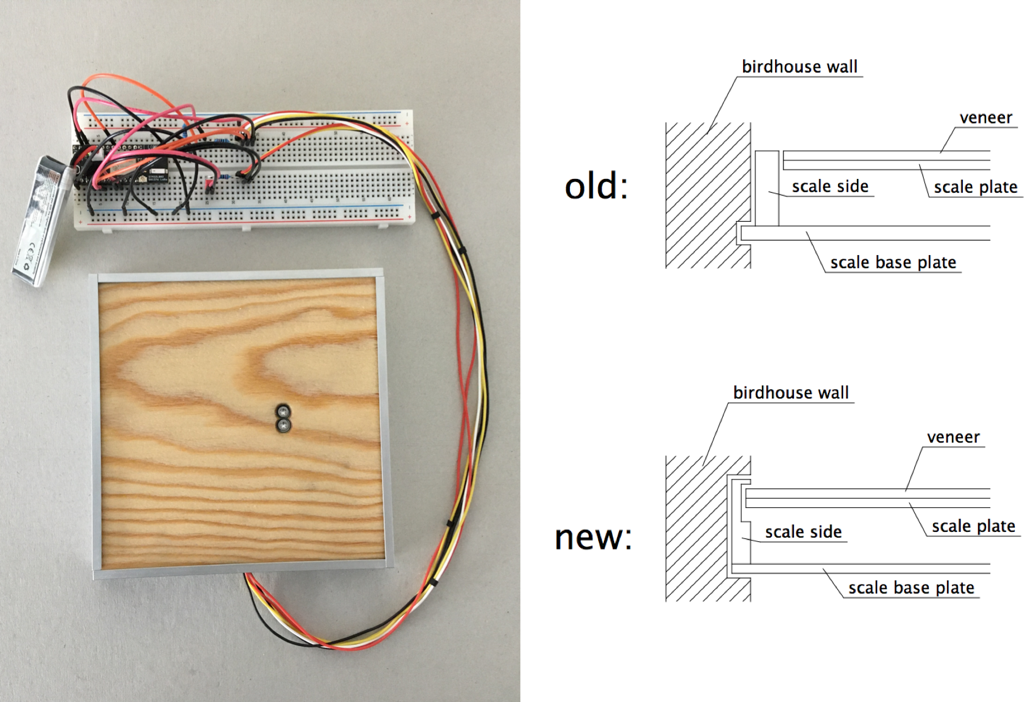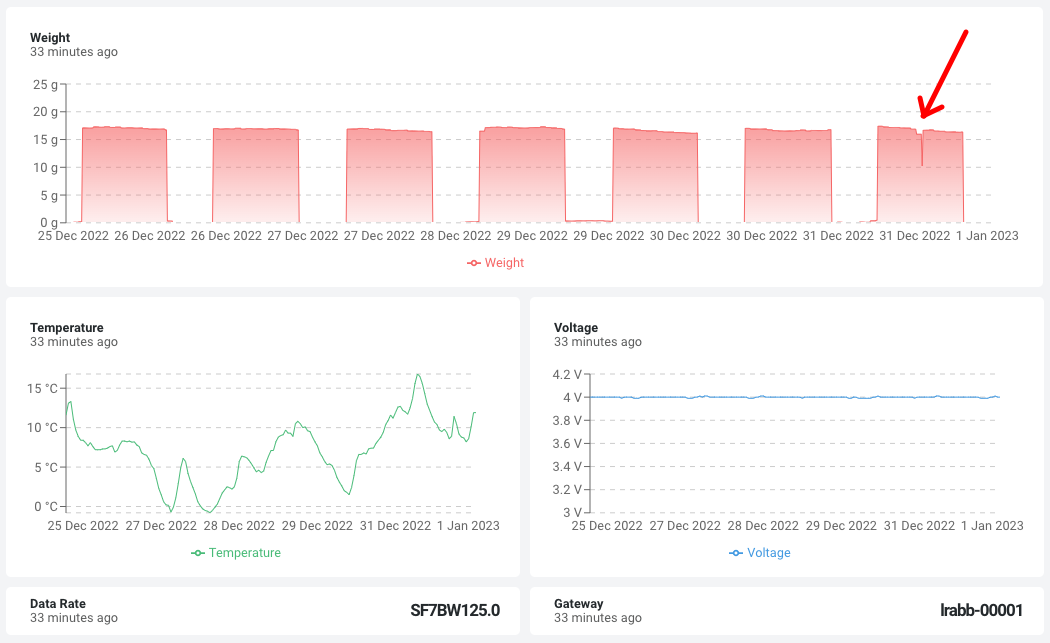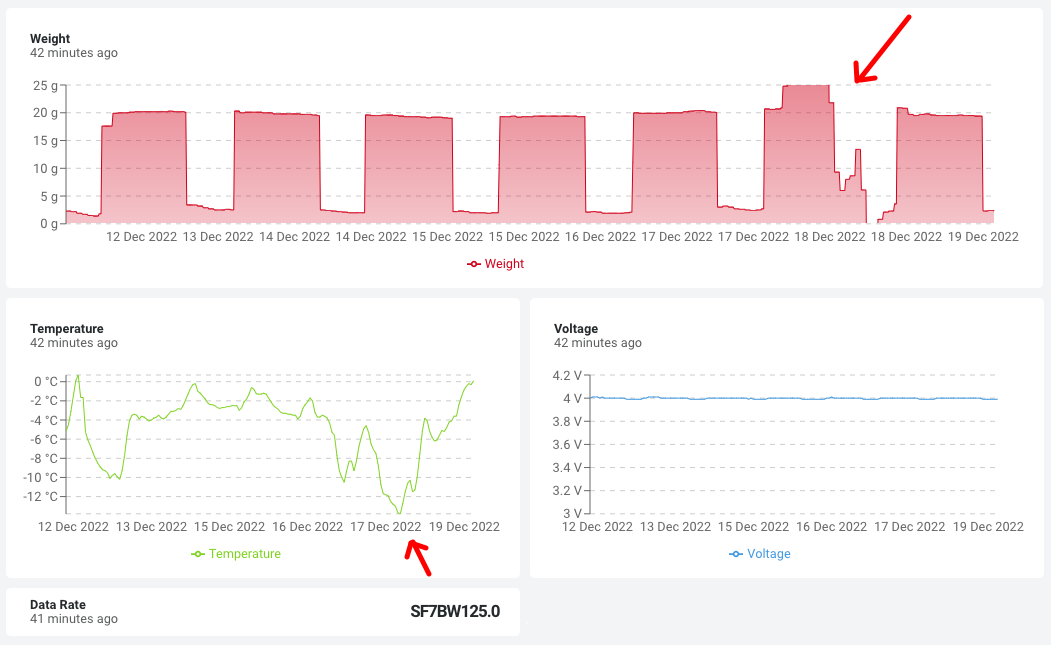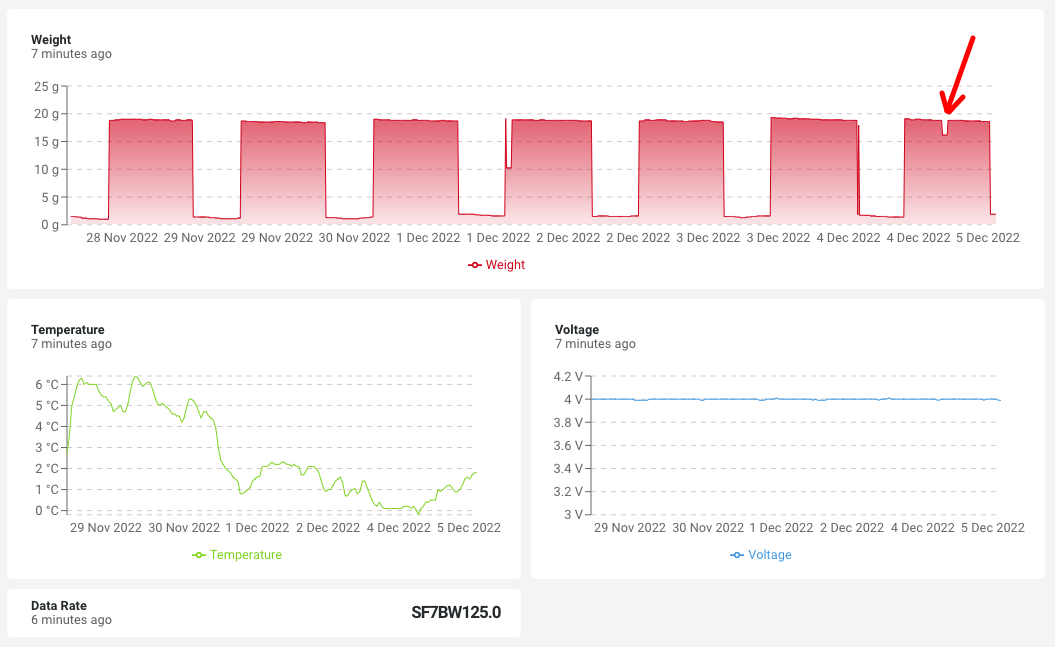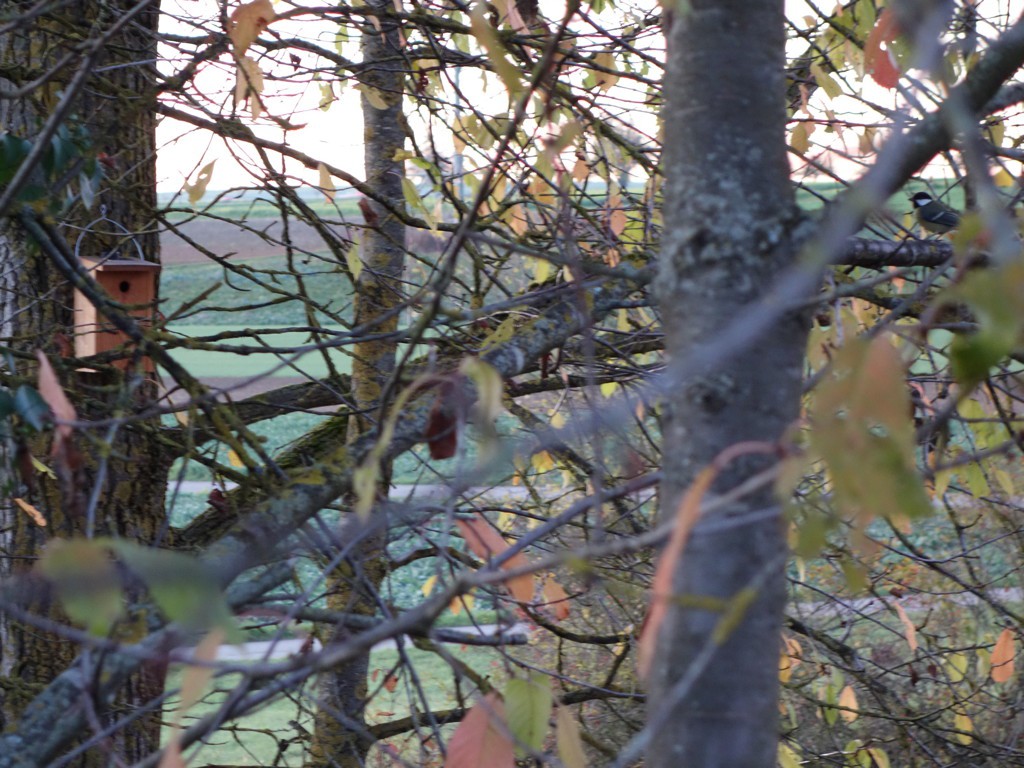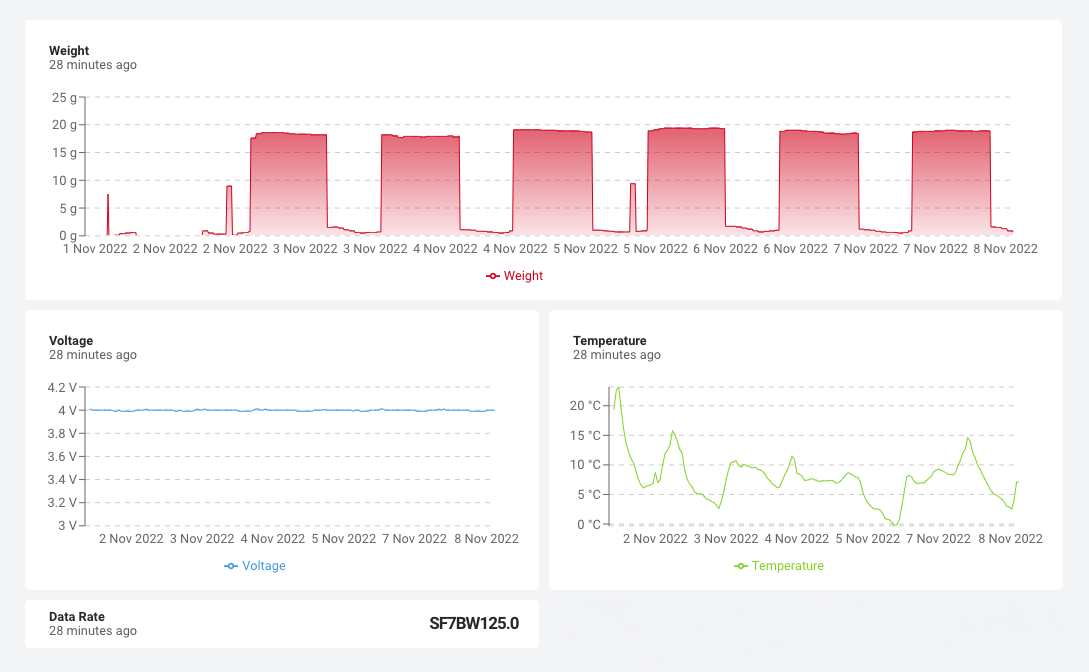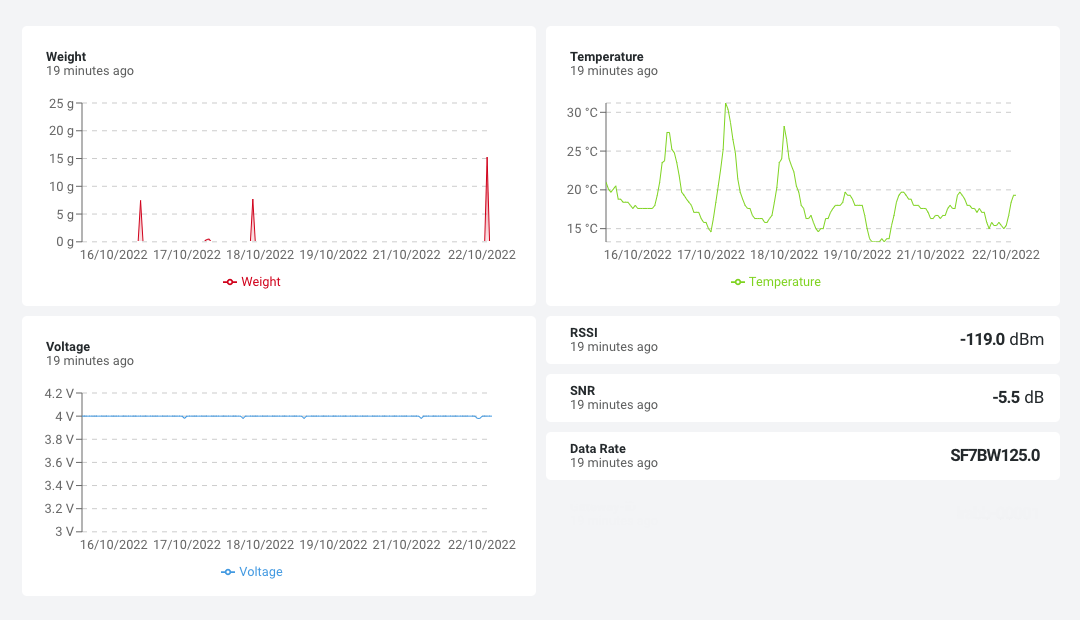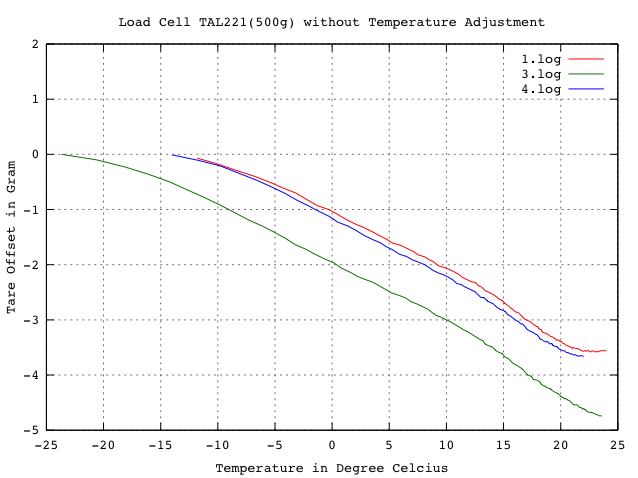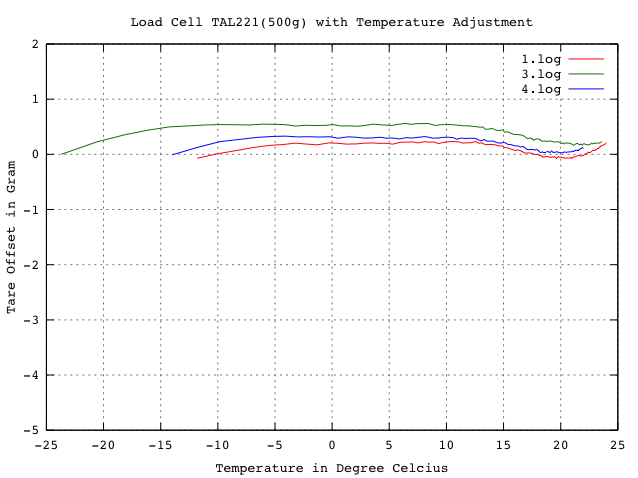-
Scale Improvements
01/23/2023 at 11:50 • 0 commentsI have started working on a new scale. The main difference is the way it is mounted into the walls of the birdhouse. With the old scale the base plate was inserted into small slits on the sides leaving the sides exposed on top. The new scale sides will disappear into the walls and will only leave the weight plate with the veneer for the little bird to step on. I hope this will produce more consistent weight readings even when the little bird leans on to the wall while sleeping.
![]()
-
Noise
01/01/2023 at 13:14 • 0 commentsYesterday was New Year and the little bird noticed the fireworks going off around midnight (please see the image below). All that noise and the flashing lights seem to cause a lot of stress for birds even when they are inside a birdhouse.
![]()
I also implemented the temperature compensation for the weight graph using a formula data field in DataCake. The formula adds/subtracts an offset to the weight depending on the temperature inside the birdhouse (please see the older posts). The baseline of the weight graph should now be closer to zero without being affected too much by temperature. Using the formula data field also gives me the chance to adjust the math for the temperature compensation online instead of having to do a software update of the birdhouse each and every time.
-
Cold Weather
12/19/2022 at 10:03 • 0 commentsYesterday the birdhouse experienced some really cold weather with temperatures below -10 °C (14 °F). The temperature readings and voltage sent by the Grasshopper were fine but the weight scale delivered some erratic values (please see the image below). The Murata module and the HX711 are specified to work down to - 40 °C. But it looks like the TAL221 load cells operating temperature is only between -10 and + 40 °C. Once the temperatures went up again the weight scale readings returned to normal. I hope the load cell did not suffer any permanent damage.
![]()
-
Drop in Weight
12/05/2022 at 08:41 • 0 commentsLooking at the dash board I noticed that the weight of the little bird sometimes drops a couple of grams during the night (please see the image below). I am guessing this happens because the little bird leans up to the wall of the birdhouse and by doing so takes one foot off the weight scale. For the next version of the birdhouse I would like the scale to be wall to wall. And I would also like to move the electronics, solar panel and antenna into a single enclosure on top of the roof. This should simplify the setup and give the birds more room on the inside.
![]()
-
Birding
11/12/2022 at 09:19 • 0 commentsNow that I know when the little bird comes and goes I thought that I might be able to get a picture of it leaving/entering the birdhouse. Yesterday evening just before sundown I took my camera and waited for the little guy to arrive. Since I don't have a tripod or a remote shutter release most images turned out to be blurry (taking good images of birds is challenging). But in the image below you can see the birdhouse and its tenant if you look closely :-) .
![]()
-
Customer
11/08/2022 at 11:18 • 0 commentsFor the last few days the birdhouse has had a nightly visitor. The little guy shows up at sundown and leaves at sunrise (a real regular :-) ). It weighs about 18 grams. Typical birds in that weight category around here include the black redstart and the great tit.
![]()
-
Upgrade
11/02/2022 at 09:45 • 0 commentsOver the past few days I have taken down the birdhouse to do the temperature sensor upgrade. The birdhouse now has the scale with the TSic 306 temperature sensor and matching Grasshopper electronics. I have also done some minor changes to the LoRaWAN payload. An additional byte has been added to expand the range of the scale weight.
I was also able to look at the birdhouse after having been hung in a tree for about four months. There were lots of dead little flies inside and I found about half a dozen little spiders living between the floor board and the scale. There was one small wet stain on the inside of the scale which probably got there during one of the downpours but otherwise looked harmless. It looks like the scale held up nicely even with all the dead bugs and spider webs inside.
-
Vacancy
10/22/2022 at 11:32 • 0 commentsEver since about mid October the birdhouse has had some visitors. They never stay long (only a couple of minutes for the scale to trigger). I'm not sure what exactly is happening there but maybe they are looking for a place to roost during the cold season :-) .
![]()
-
Temperature Adjustments
08/12/2022 at 16:01 • 0 commentsWith the TSic 306 installed in the scale I got thinking on how to measure the temperature drift of the load cell. I needed some way to cool and warm the scale just like when it's exposed to weather in the birdhouse. I eventually decided to put the scale into a small cardboard box and from there into the freezer of my refrigerator. There it could cool down over night and in the morning I would take it out and hook it up to the Grasshopper to watch it thaw. While it was thawing the Grasshopper would probe the weight of the empty scale and also record the changing temperature. In the image below you can see the tare point of the load cell change with the temperature:
![]()
The image shows three measurement series (1.log, 3.log, 4.log). The Grasshopper did a tare first thing after getting the scale out of the freezer. And after that you can see the tare point sink further and further the warmer the scale gets. The measurement series are almost linear which should make it easy to compensate using the formula below:
After applying this correction the measurement series look like this:
![]()
Using this simple formula the temperature drift changed from 4-5g to less than 0.5g over the temperature range measured. Implementing this into the Grasshopper should not be difficult. But it remains to be seen if this will also work in a real world environment.
-
New Thermometer
08/09/2022 at 05:28 • 0 commentsI have been testing the DS18B20 thermometer over the past few days. There are some drawbacks using the One Wire protocol (it's a bit complicated). I also had some issues turning off the DS18B20 to save power. The DS18B20 has a low standby mode of less than 1 µA but I wanted to turn it off completely which proved to be difficult. So I started looking for an alternative thermometer. After some searching I found the TSic 306 which turned out to be really nice. It is a pre calibrated digital thermometer just like the DS18B20 and also comes in a TO-92 package. It uses the much simpler ZACwire protocol to communicate with the micro controller. And it can be turned off completely between temperature readings to save power. Initial tests of the TSic 306 are looking good. Next I will have to come up with a setup to measure the temperature dependency of the load cell.
 Jan Schlieper
Jan Schlieper